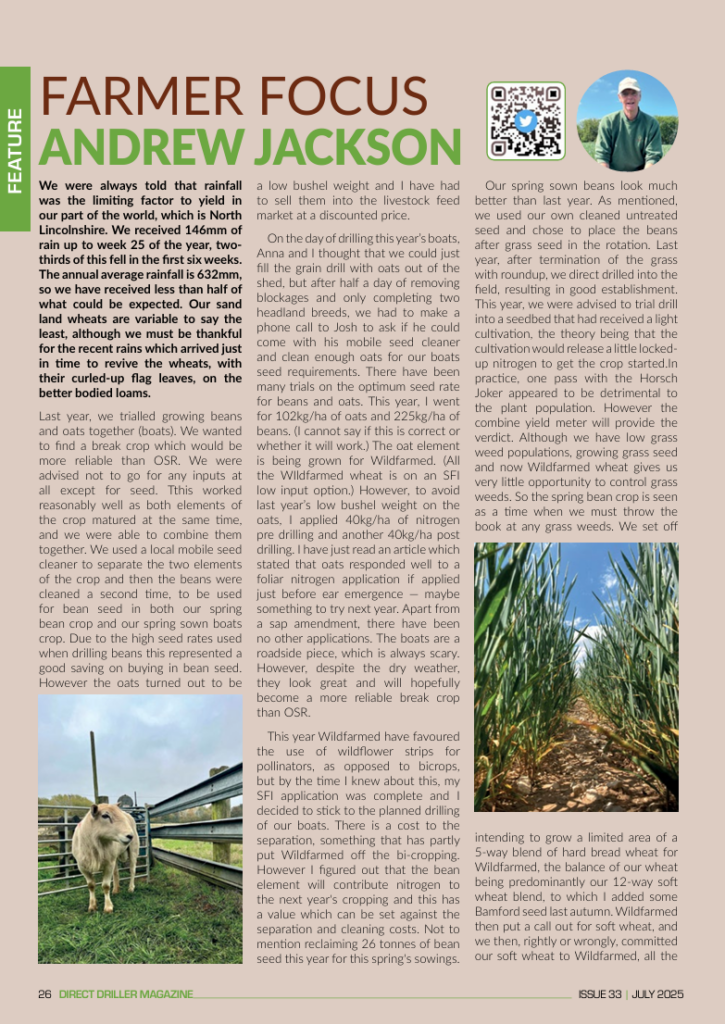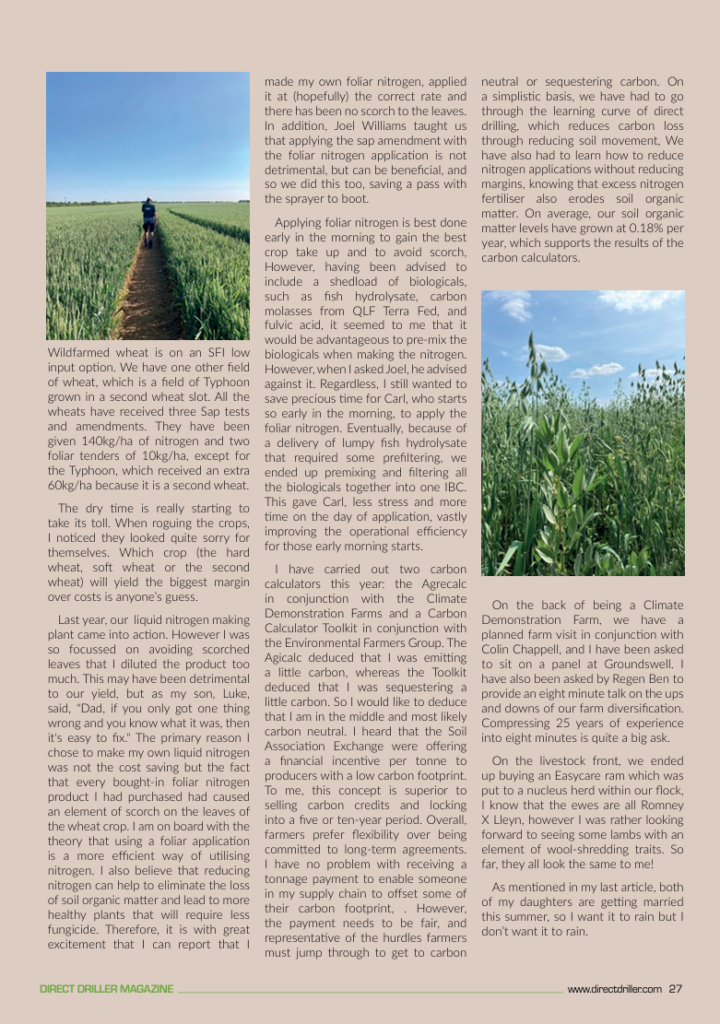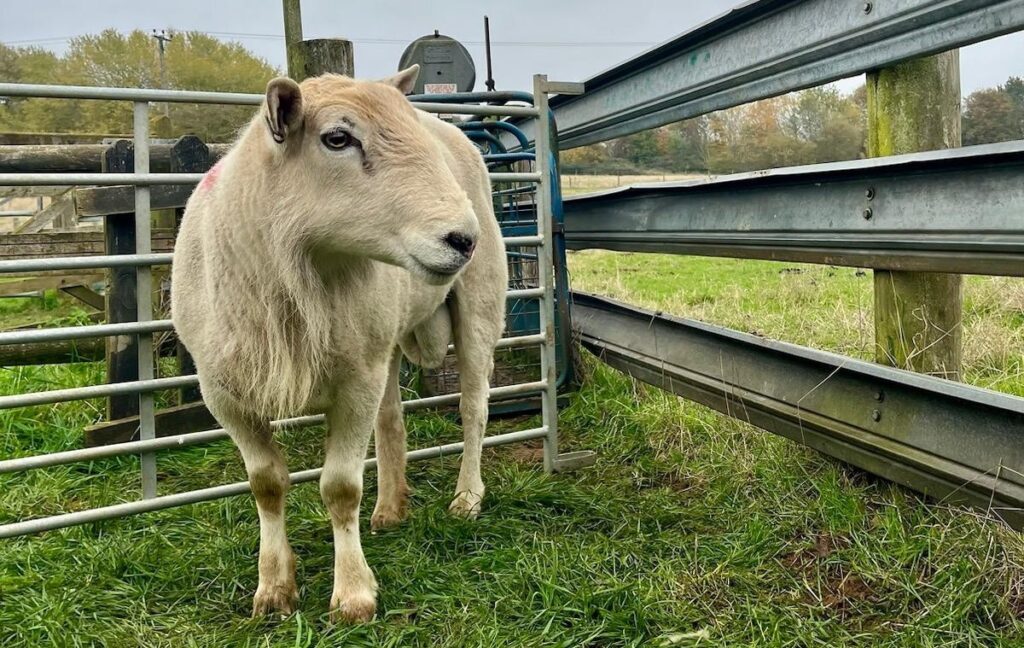We were always told that rainfall was the limiting factor to yield in our part of the world, which is North Lincolnshire. We received 146mm of rain up to week 25 of the year, twothirds of this fell in the first six weeks. The annual average rainfall is 632mm, so we have received less than half of what could be expected. Our sand land wheats are variable to say the least, although we must be thankful for the recent rains which arrived just in time to revive the wheats, with their curled-up flag leaves, on the better bodied loams.
Last year, we trialled growing beans and oats together (boats). We wanted to find a break crop which would be more reliable than OSR. We were advised not to go for any inputs at all except for seed. Tthis worked reasonably well as both elements of the crop matured at the same time, and we were able to combine them together. We used a local mobile seed cleaner to separate the two elements of the crop and then the beans were cleaned a second time, to be used for bean seed in both our spring bean crop and our spring sown boats crop. Due to the high seed rates used when drilling beans this represented a good saving on buying in bean seed. However the oats turned out to be a low bushel weight and I have had to sell them into the livestock feed market at a discounted price.
On the day of drilling this year’s boats, Anna and I thought that we could just f ill the grain drill with oats out of the shed, but after half a day of removing blockages and only completing two headland breeds, we had to make a phone call to Josh to ask if he could come with his mobile seed cleaner and clean enough oats for our boats seed requirements. There have been many trials on the optimum seed rate for beans and oats. This year, I went for 102kg/ha of oats and 225kg/ha of beans. (I cannot say if this is correct or whether it will work.) The oat element is being grown for Wildfarmed. (All the WIldfarmed wheat is on an SFI low input option.) However, to avoid last year’s low bushel weight on the oats, I applied 40kg/ha of nitrogen pre drilling and another 40kg/ha post drilling. I have just read an article which stated that oats responded well to a foliar nitrogen application if applied just before ear emergence — maybe something to try next year. Apart from a sap amendment, there have been no other applications. The boats are a roadside piece, which is always scary. However, despite the dry weather, they look great and will hopefully become a more reliable break crop than OSR.
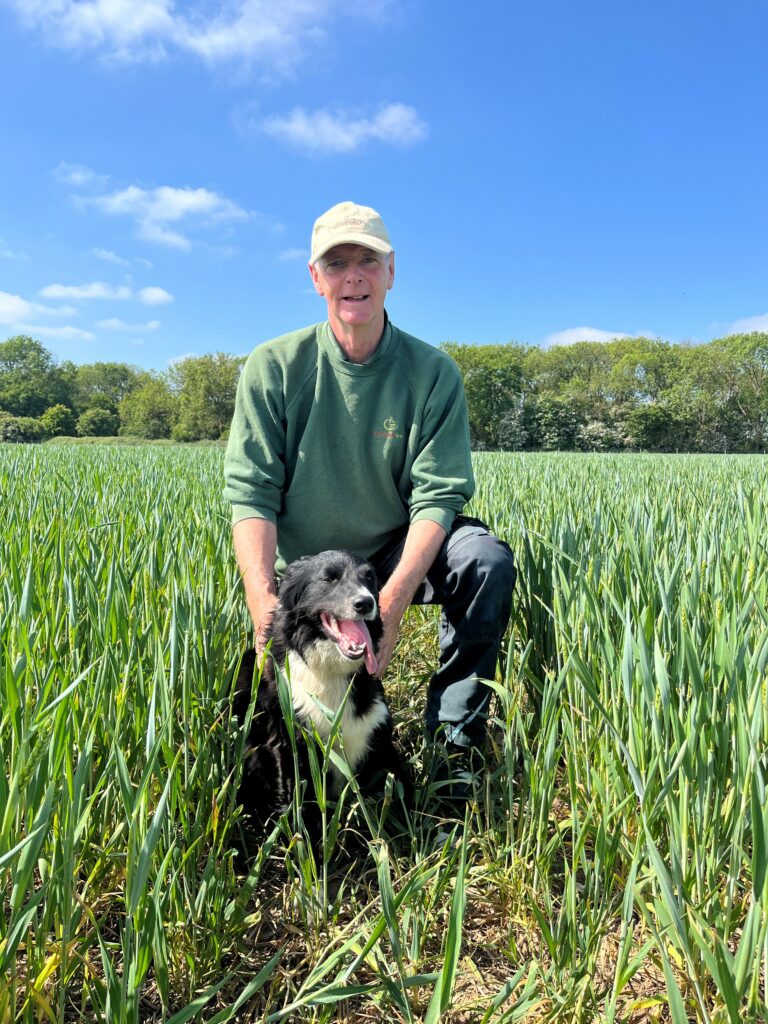
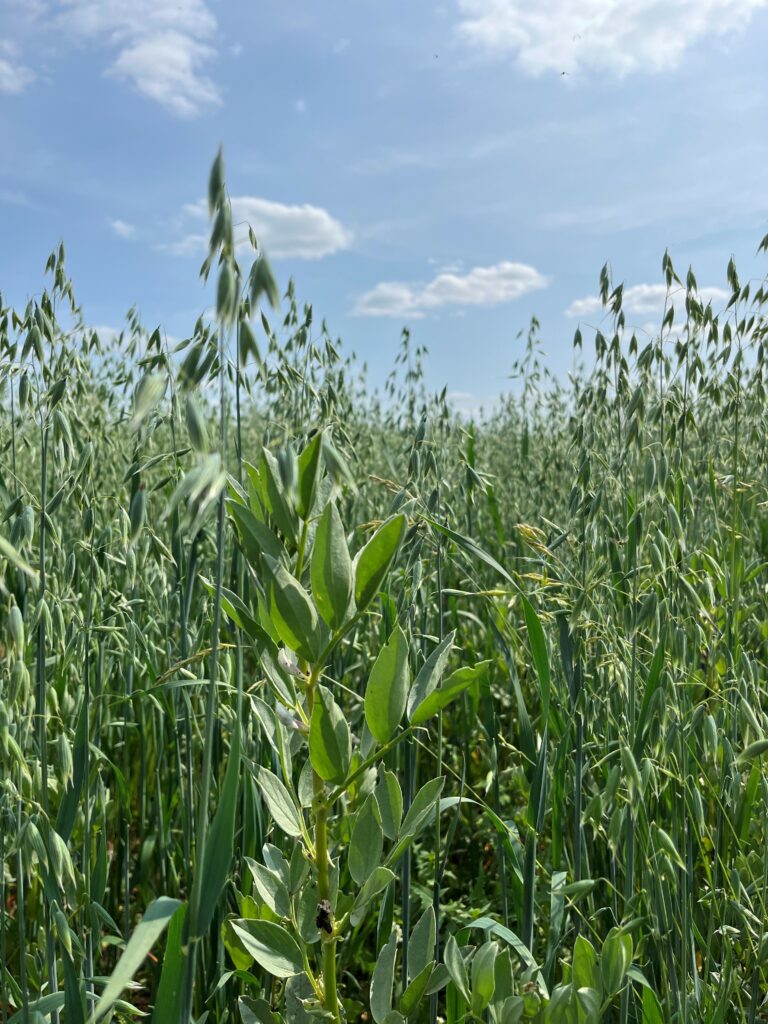
This year Wildfarmed have favoured the use of wildflower strips for pollinators, as opposed to bicrops, but by the time I knew about this, my SFI application was complete and I decided to stick to the planned drilling of our boats. There is a cost to the separation, something that has partly put Wildfarmed off the bi-cropping. However I figured out that the bean element will contribute nitrogen to the next year’s cropping and this has a value which can be set against the separation and cleaning costs. Not to mention reclaiming 26 tonnes of bean seed this year for this spring’s sowings.
Our spring sown beans look much better than last year. As mentioned, we used our own cleaned untreated seed and chose to place the beans after grass seed in the rotation. Last year, after termination of the grass with roundup, we direct drilled into the f ield, resulting in good establishment. This year, we were advised to trial drill into a seedbed that had received a light cultivation, the theory being that the cultivation would release a little lockedup nitrogen to get the crop started.In practice, one pass with the Horsch Joker appeared to be detrimental to the plant population. However the combine yield meter will provide the verdict. Although we have low grass weed populations, growing grass seed and now Wildfarmed wheat gives us very little opportunity to control grass weeds. So the spring bean crop is seen as a time when we must throw the book at any grass weeds.
We set off intending to grow a limited area of a 5-way blend of hard bread wheat for Wildfarmed, the balance of our wheat being predominantly our 12-way soft wheat blend, to which I added some Bamford seed last autumn. Wildfarmed then put a call out for soft wheat, and we then, rightly or wrongly, committed our soft wheat to Wildfarmed, all the Wildfarmed wheat is on an SFI low input option. We have one other field of wheat, which is a field of Typhoon grown in a second wheat slot. All the wheats have received three Sap tests and amendments. They have been given 140kg/ha of nitrogen and two foliar tenders of 10kg/ha, except for the Typhoon, which received an extra 60kg/ha because it is a second wheat.
The dry time is really starting to take its toll. When roguing the crops, I noticed they looked quite sorry for themselves. Which crop (the hard wheat, soft wheat or the second wheat) will yield the biggest margin over costs is anyone’s guess.
Last year, our liquid nitrogen making plant came into action. However I was so focussed on avoiding scorched leaves that I diluted the product too much. This may have been detrimental to our yield, but as my son, Luke, said, “Dad, if you only got one thing wrong and you know what it was, then it’s easy to fix.” The primary reason I chose to make my own liquid nitrogen was not the cost saving but the fact that every bought-in foliar nitrogen product I had purchased had caused an element of scorch on the leaves of the wheat crop. I am on board with the theory that using a foliar application is a more efficient way of utilising nitrogen. I also believe that reducing nitrogen can help to eliminate the loss of soil organic matter and lead to more healthy plants that will require less fungicide. Therefore, it is with great excitement that I can report that I made my own foliar nitrogen, applied it at (hopefully) the correct rate and there has been no scorch to the leaves. In addition, Joel Williams taught us that applying the sap amendment with the foliar nitrogen application is not detrimental, but can be beneficial, and so we did this too, saving a pass with the sprayer to boot.
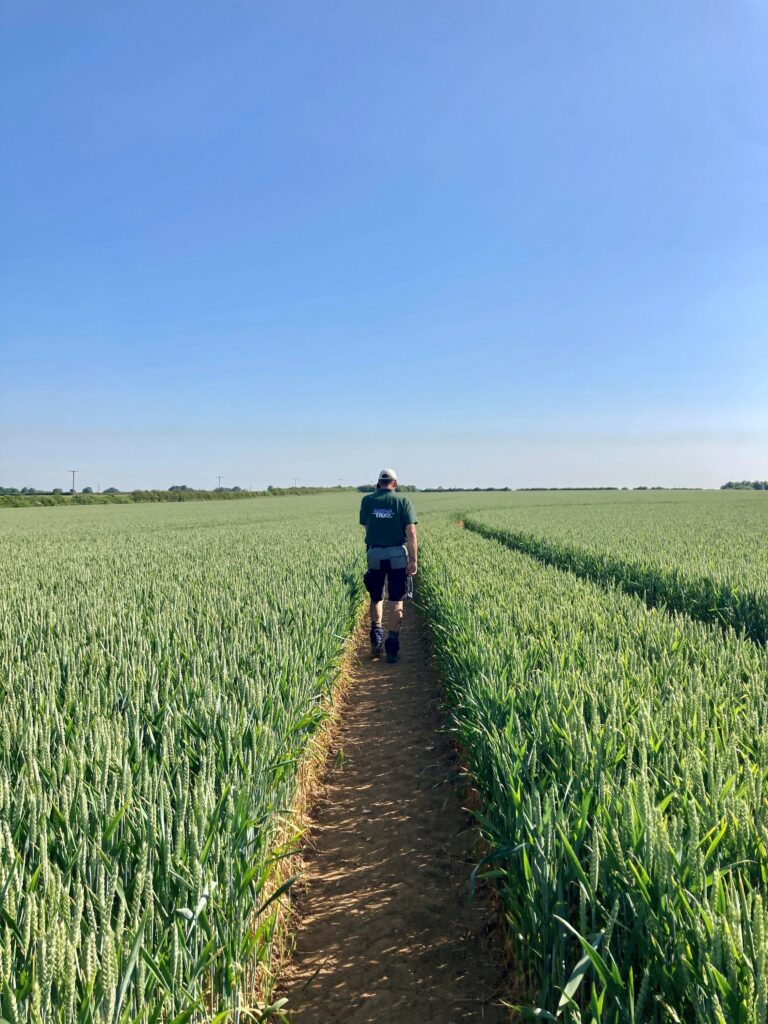

Applying foliar nitrogen is best done early in the morning to gain the best crop take up and to avoid scorch, However, having been advised to include a shedload of biologicals, such as fish hydrolysate, carbon molasses from QLF Terra Fed, and fulvic acid, it seemed to me that it would be advantageous to pre-mix the biologicals when making the nitrogen. However, when I asked Joel, he advised against it. Regardless, I still wanted to save precious time for Carl, who starts so early in the morning, to apply the foliar nitrogen. Eventually, because of a delivery of lumpy fish hydrolysate that required some prefiltering, we ended up premixing and filtering all the biologicals together into one IBC. This gave Carl, less stress and more t ime on the day of application, vastly improving the operational efficiency for those early morning starts.
I have carried out two carbon calculators this year: the Agrecalc in conjunction with the Climate Demonstration Farms and a Carbon Calculator Toolkit in conjunction with the Environmental Farmers Group. The Agicalc deduced that I was emitting a little carbon, whereas the Toolkit deduced that I was sequestering a little carbon. So I would like to deduce that I am in the middle and most likely carbon neutral. I heard that the Soil Association Exchange were offering a f inancial incentive per tonne to producers with a low carbon footprint. To me, this concept is superior to selling carbon credits and locking into a five or ten-year period. Overall, farmers prefer flexibility over being committed to long-term agreements. I have no problem with receiving a tonnage payment to enable someone in my supply chain to offset some of their carbon footprint, . However, the payment needs to be fair, and representative of the hurdles farmers must jump through to get to carbon neutral or sequestering carbon. On a simplistic basis, we have had to go through the learning curve of direct drilling, which reduces carbon loss through reducing soil movement, We have also had to learn how to reduce nitrogen applications without reducing margins, knowing that excess nitrogen fertiliser also erodes soil organic matter. On average, our soil organic matter levels have grown at 0.18% per year, which supports the results of the carbon calculators.
On the back of being a Climate Demonstration Farm, we have a planned farm visit in conjunction with Colin Chappell, and I have been asked to sit on a panel at Groundswell. I have also been asked by Regen Ben to provide an eight minute talk on the ups and downs of our farm diversification. Compressing 25 years of experience into eight minutes is quite a big ask.
On the livestock front, we ended up buying an Easycare ram which was put to a nucleus herd within our flock, I know that the ewes are all Romney X Lleyn, however I was rather looking forward to seeing some lambs with an element of wool-shredding traits. So far, they all look the same to me! As mentioned in my last article, both of my daughters are getting married this summer, so I want it to rain but I don’t want it to rain.
